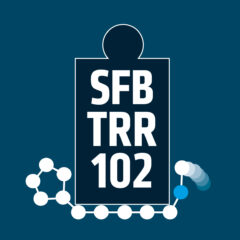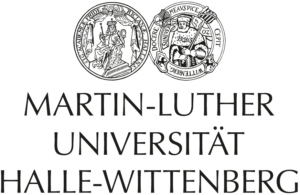Alexander Korn on “Structural and Functional Investigations of the F19-L34 Contact in Aβ(40)”
and Ricardo Kurz on “Charakterisierung teilkristalliner Polymere mittels Festkörper-NMR” (rehearsal in German)
Location: UL, Linnéstr. 5, SR 224 Time: 3.30pm-5.00pm Link to Google-Maps
Abstracts
Structural and Functional Investigations of the F19-L34 Contact in Aβ(40)
Alexander Korn
Correct folding is essential for the functionality of all proteins. Although this folding process is highly regulated misfolding regularly occurs and leads to intra and extracellular aggregates which accumulate during aging and are associated with a variety of diseases. A special misfolding pathway is the formation of protein fibrils which are characterized by a secondary structure composed of two stacked β-sheets, called cross-β structure.
Amyloid β is a short peptide and its fibrillary plaques are a hallmark of Alzheimer’s disease. We use Aβ(40), the 40 amino acid long variant of this peptide, as a model system to investigate the fibrillation pathway under different constraints introduced by mutational strategies. We tested three libraries of mutations: 1) replacement of F19 by amino acids with very distinct properties (glycine, proline, lysine, glutamic acid, tyrosine, tryptophan); 2) replacement of L34 by very similar amino acids (valine, isoleucine, D-leucine; 3) replacement of F19 by very similar non-proteinogenic amino acids. The latter group comprised cyclohexyl-alanine with a saturated ring system, 1-naphthyl-alanine with a naphthalene ring system as well as homophenylalanine and phenylglycine which have a side chain that is one CH2 group longer or shorter, respectively.
The overall fibril morphology and structure remained unaltered and only the first set of severe mutations showed clear effects on the local secondary structure. In contrast, all mutations affected fibrillation kinetics and toxicity, independent on the nature of the mutation. To better understand the processes involved in the initiation of fibrillation and the effects on cells we now start to shift our focus from studies of fibrils to the oligomer formation process. First experiments on oligomers could reproduce the effects observed on fibrils and indicate that the nature of the ring system is more important than the length of the side chain. However, the sensitivity of the process and the metastable nature of oligomers render experiments difficult and request further work to confirm initial results and get further insights on the early misfolding steps.
Characterization of semi-crystalline polymers using solid state NMR
Ricardo Kurz
Polymers are used in a wide variety of applications in everyday life as well as in science, industry and technology. The investigation of their macroscopic properties depending on their processing is an elementary component of polymer research. Most of the polymers crystallize on cooling and possess a semi-crystalline structure. The formation of this structure depends on the crystallization conditions and the presence of intra-crystalline mobility. The influence of the dynamics of the amorphous phase remaining after crystallization on the structure formation as well as the intracrystalline dynamics were investigated. Characteristic differences in the formation of the final structure could be determined and an attempt was made to develop a crystallization model for polymer melts from these.





One thought on “Doctoral students seminar (September 4, 2018)”